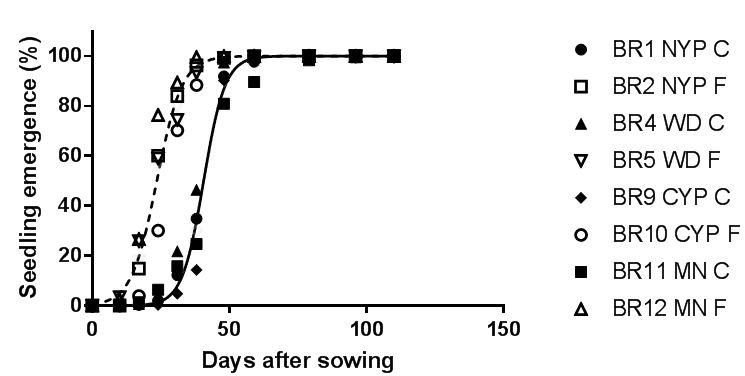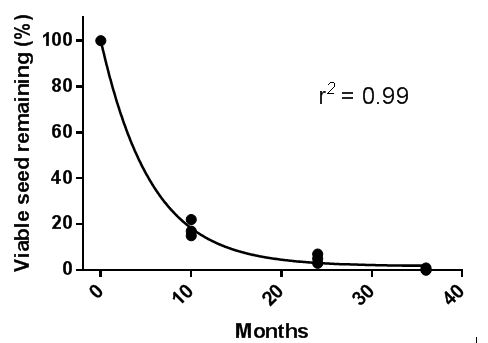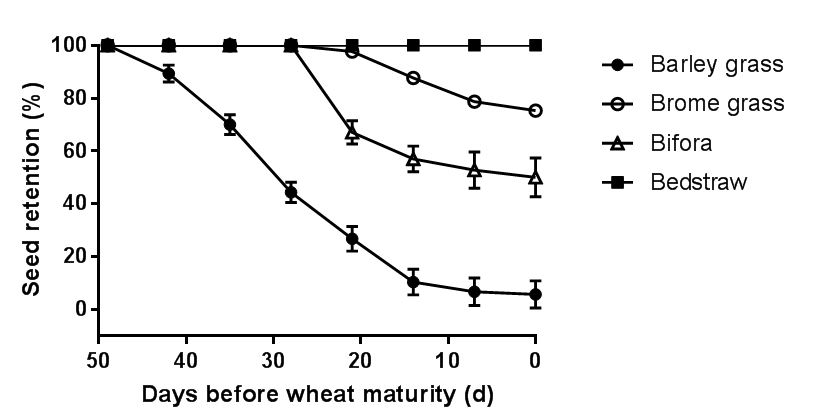Latest research on brome grass and susceptibility of emerging weed species to harvest weed seed capture and control
Author: Sam Kleemann, Ben Fleet, Chris Preston, Gurjeet Gill (School of Agriculture, Food & Wine, The University of Adelaide). | Date: 20 Feb 2018
Take home messages:
- Increasing incidence of brome grass in cropping paddocks in southern Australia appears to be associated with selection of biotypes with greater seed dormancy by crop management practices used by growers.
- Higher levels of seed dormancy allow brome to germinate and establish after pre-sowing weed management, resulting in greater in-crop weed establishment. This change in weed behaviour also appears to be associated with increased seedbank persistence from one year to the next (approximately 25%). Therefore, multi-year control strategies are required to exhaust brome seedbanks to low levels. Growers need to plan a three year management program for their cropping rotations.
- Several experimental herbicides have been evaluated for brome control in wheat. Whilst some experimental treatments provided effective weed control (>80%), crop safety was inadequate in cereals.
- Weed seed dispersal prior to crop harvest differed greatly between weed species. Bedstraw, statice, turnip weed and Indian hedge mustard showed no dispersal (100% retained), seed retention was much higher for bifora (50%) and brome grass (75%) relative to sowthistle (<35%) and barley grass (<6%). Barley grass is extremely prone to early seed dispersal and harvest weed seed control (HWSC) tactics are unlikely to improve weed management.
- Prickly lettuce seed production occurred after crop harvest, thereby limiting the effectiveness of HWSC — weed control should focus on post-harvest management (i.e. non-selective herbicides).
- A preliminary kiln study showed that temperatures in excess of 450°C for at least 40s were required to guarantee the complete kill of brome grass seed. As burning standing stubbles is unlikely to provide the required level of heat exposure, narrow windrow burning should be considered to improve weed seed kill.
Brome grass ecology and management
Brome grass (Bromus diandrus, great brome) has increased in prevalence across the Victorian Mallee, which appears to be related to increased adoption of no-till farming and intensification of cereal-based cropping systems (i.e. wheat on wheat), where few effective selective herbicides are available for its control.
Similar trends of increasing dominance of brome have been observed in the SA Mallee and in the Mid-North and many other areas of the state. Some of the increase in brome grass abundance in crops can also be explained by the adoption of earlier sowing or even dry sowing. In situations where brome grass has become a serious issue, it can reduce wheat yields by as much as 30% to 50%.
On-farm selection for increased seed dormancy and delayed seedling emergence after the opening rains appears to be responsible for the increasing dominance of this weed species. Our research has clearly shown higher levels of seed dormancy in brome grass populations collected from cropping fields than those from non-crop situations such as fence-lines or roadsides (Figure 1).
Populations collected from intensively cropped situations at the end of 2015 were much slower to emerge and reach 50% of final emergence (t50) than those sourced from the fence-line (cropped t50 approximately 40 d; fence-line t50 approximately 20 d). This two-fold difference in seedling emergence time between brome populations was related to the variation in seed dormancy.
Figure 1. Differences in germination and seedling emergence pattern between cropped (closed symbols — solid line) and adjacent fence-line (open symbols— broken line) populations of great brome collected in 2015 across south-eastern Australia.
These results clearly indicate that management practices used by growers to control brome in cropping paddocks have caused a shift in weed population behaviour. This increase in seed dormancy has been caused by selection of individuals in these populations that possess genes for greater seed dormancy that enables them to escape pre-sowing weed control tactics such as tillage or knockdown herbicides. The process of selection for increased seed dormancy would be very similar, but slower than selection for herbicide resistance. Over time, weed management practices in cropping paddocks would select for biotypes that possess higher dormancy and select against or remove those with low dormancy. Such selection pressure would not occur on the fence-line or non-crop areas or pastures.
Seed of highly dormant populations of brome grass was responsive to chilling (i.e. exposure to 5°C), a process which has been shown to increase gibberellic acid production within the seed, a hormone known to stimulate germination. In the field this means that the dormant brome grass seed requires not only moisture, but also a period of colder temperatures to germinate. Therefore, germination of most of the seedbank of brome would not occur until cooler-moist conditions in late autumn-early winter, thus allowing it to evade early season weed control tactics (e.g. knockdown herbicides).
Another biological mechanism that appears to delay seedling emergence in the field is the strong inhibitory effect of light on seed germination in brome grass. Strong photo-inhibition is likely to aid brome infestation in the field by enabling seeds to remain ungerminated on the soil surface, even after adequate rainfall, until after the sowing of the crop, thus preventing seedlings from being killed by seed-bed preparation practices. This feature of brome grass ecology also goes some way to explaining why it has proliferated under no-till, where seeds remain on the soil surface until being buried by the sowing pass, which would remove the inhibitory effect of light.
Figure 2. Longevity of brome grass seed in the field at Lock from 2003 to 2006.
Greater seed dormancy in brome grass populations from cropping fields could have also contributed to the development of a more persistent seedbank. A field study undertaken at Lock showed that 20% of the seedbank of brome persisted from one season to the next, with seeds remaining viable in the soil for up to three years (Figure 2). Similar levels of persistence were also shown in the long-term study at Balaklava, where more than 25% of seedbank persisted from one season to the next. Seedbank carryover of this magnitude could be an important factor in the proliferation of brome grass where crop rotations have often provided effective control just for one year (i.e. pasture-wheat rotation) or under cereal monoculture where no effective herbicide options were available prior to the introduction of the Clearfield® cereals.
Given the nature of seedbank persistence of brome grass, long-term control of brome would need an effective multi-year management program. Fortunately, the introduction of imidazolinone-tolerant wheat (Clearfield®) has widened growers’ options for the management of brome in the wheat-phase. Use of break crops such as legume or canola in combination with Clearfield® cereals can provide a range of herbicide options for brome control and can be included in a rotation to prevent seed set. However, brome is a prolific seed producer (80-270 seeds/plant) and weed populations can rebound sharply if weak management tactics are used for its control.
Recognising the need to find alternative herbicide options to the heavily used Group A and B herbicides, several herbicide efficacy trials funded by GRDC (projects UCS00020 and UQ00080) have been undertaken over the past seven years in SA and Victoria (VIC). The trials have compared several new and experimental pre-emergent options in wheat. Several experimental herbicides have been evaluated alone or as tank mixtures. While some of these treatments provided excellent brome control (>80%), crop safety in cereals was inadequate. Sakura® plus Avadex® provided the highest pre-emergent brome control (averaging >70%) in most of the field trials . However, where moisture conditions were inadequate, or the weed pressure high, this mixture was ineffective (<40%).
Weed seed dispersal and susceptibility of emerging weeds to harvest weed seed capture and control
At present, there is growing interest in the grains industry in HWSC including weed seed catchers, weed seed destructor technologies, and narrow windrow burning. The effectiveness and therefore suitability of these practices depend on the amount of weed seed retained on the plant and present above the cutter bar height at crop harvest. Field studies conducted over the past two seasons at Roseworthy have investigated the seed shedding behaviour of several emerging weeds until the crop was harvest-ready (≤12% moisture content).
The pattern of seed shedding was determined by regularly collecting seeds from seed traps placed on the soil surface in the crop canopy. A preliminary kiln study was also recently undertaken to investigate the burning temperatures and duration required to provide weed seed control in the context of narrow windrow burning. Here only data for brome grass (Table 2) is presented.
Barley grass (H. glaucum) was particularly prone to early seed dispersal and only <6% of seeds produced were retained in panicles at the harvest-ready stage of wheat (Figure 3). Barley grass was also the first weed spp. to reach maturity, producing viable seeds and initiating seed shed at 60 to 65 days, and 43 to 45 days before crop harvest. Relative to barley grass, bifora and brome grass (B. diandrus) were slower to reach physiological maturity (30 to 40 days) and initiate seed shed 21 to 25 days before crop harvest.
Weed seed retention was much higher for bifora (50%), brome grass (75%) and bedstraw showed no seed dispersal prior to crop harvest (100% retained). Even though brome grass had high seed retention (75%) until harvest, many panicles (30% to 80%) had lodged below the crop harvest height of 15cm (Table 1). The severity of lodging in brome grass increased with weed density, which could be related to weaker stems at its higher density and this could be an important escape mechanism from HWSC for this species.
Preliminary results from the past season showed that more than 65% of sowthistle flowers had already released seed prior to lentil harvest whereas in wheat, seed dispersal was much lower due to greater weed suppression caused by crop competition. Similar to bedstraw, statice, turnip weed and Indian hedge mustard showed no dispersal prior to the harvest-ready stage of both wheat and lentils (100% retained).
Table 1. Effect of brome and barley grass density (low, medium and high) on panicle lodging at the harvest-ready stage of wheat (≤12% moisture content). Panicles found ≤15cm crop harvest height were scored as lodged.
Weed density | Brome grass | Barley grass |
|---|---|---|
(plants m2) | % panicles ≤15cm harvest height | |
Low (10-20) | 30 ± 18.2 | 73 ± 4.1 |
Medium (35-50) | 47 ± 11.4 | 63 ± 2.7 |
High (140-200) | 80 ± 2.0 | 68 ± 2.4 |
Despite prickly lettuce emerging within a month of sowing, flowering was not observed even for the most advanced plants at lentil harvest. As most seed production in prickly lettuce appears to take place after crop harvest, HWSC is not a practical option for this weed species. Rather, non-selective herbicides should be used post-harvest, when regrowth is fresh and plants are likely to be more vulnerable to control.
Figure 3. Seed retention of brome grass (unshaded circle) relative to barley grass (shaded circle), bifora (triangle) and bedstraw (square) in relation to wheat maturity (≤12% grain moisture content) at Roseworthy in 2016. Bars show ± SE.
Based on the level of seed dispersal observed in this study, bedstraw, statice, turnip weed, and Indian hedge mustard were the most suitable weed species for harvest weed seed capture. Despite bifora and brome grass shedding some seed prior to harvest, more than 50% of seeds were retained for HWSC. In contrast, sowthistle and barley grass appear to be the least suitable weed species for HWSC and show a high level of shed seed prior to crop harvest.
Results from a preliminary kiln study showed that both temperature and duration of exposure were important factors for killing weed seeds (only brome grass data presented). Temperatures in excess of 450°C for at least 40s were required to achieve complete kill of brome grass seeds (Table 2). Even at these high temperatures (450°C), short exposure (20s) failed to completely kill brome seeds with more than 68% remaining viable after the treatment. These preliminary results clearly suggest that short hot burns associated with burning standing stubbles are likely to be inadequate for achieving a high level of weed seed kill. Therefore, narrow windrows of high biomass are required to generate the temperatures and exposure times needed for killing brome grass seed.
Table 2. Effect of temperature and duration of exposure on the percentage (%) germination (survival) of brome grass seed. Values in mean column with different letters are significantly different (P = 0.05). SAGIT funded project (S416).
Duration (s) | Temperature (oC) | |||||
|---|---|---|---|---|---|---|
200 | 250 | 300 | 350 | 400 | 450 | |
20 | 100 a | 98 a | 100 a | 91 a | 71 b | 68 b |
40 | 97 a | 93 a | 98 a | 59 b | 7 c | 0 c |
60 | 98 a | 89 a | 72 b | 2 c | 0 c | 0 c |
Even though our studies have shown that several weed species retain most of their seed until crop harvest, little is known about the proportion of weed seed that subsequently exits in the grain, straw and chaff fractions under commercial harvest conditions. An important factor in many HWSC systems (i.e. chaff carts, chaff lining and HSD) is that they only target the portion of weed seed exiting the harvester in the chaff fraction. Narrow windrow burning is the exception and will control weed seeds exiting both in the straw and chaff fractions provided a hot and long burn is achieved. Further research is therefore required to clarify this aspect of weed seed collection to determine the relative effectiveness of each HWSC system in the long-term management of these emerging weeds.
Acknowledgments
The research undertaken as part of this project is made possible by the significant contributions of growers through both trial cooperation and the support of the GRDC. The author would like to thank them for their continued support.
We are also grateful to Jerome Martin and Malinee Thongmee from UA for providing technical assistance. We also acknowledge the South Australian Grains Industry Trust Fund for funding the project (S416) – Burning of weed seeds in the low rainfall systems project.
Contact details
Sam Kleemann
Waite Campus, PMB 1, Glen Osmond, SA, 5064
(08) 8313 7661
samuel.kleemann@adelaide.edu.au
Gurjeet Gill
08 8313 7744
gurjeet.gill@adelaide.edu.au
Was this page helpful?
YOUR FEEDBACK



